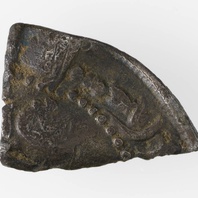
Viking Objects
Abbasid Silver Dirham Fragment (CM_1775_2008)
A silver dirham fragment possibly minted at al-`Abbasiyya. The dirham was a unit of weight used across North Africa, the Middle East, and Persia, with varying values which also referred to the type of coins used in the Middle East during the Viking Age. These coins were extremely prized possessions not only for their silver value but as a way of displaying one’s wealth and vast trade connections. Millions of Arabic dirhams would have been imported throughout the Viking world and are mostly found in hoards.
Read More
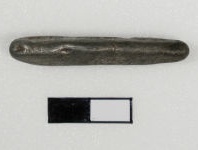
Viking Objects
Silver Ingot (2010-195)
Ingots of this size and shape were used as a convenient way to store and carry silver in the Viking Age. They might be cut up into pieces (hacksilver) to be used as bullion for payments, or be processed into jewellery. Analysis of silver ingots from this period shows that many were made from silver mined in the Middle East. This silver was probably originally used to mint Arabic dirhams (a type of coin) but was melted down by the Vikings to make it more easily portable.
Read More
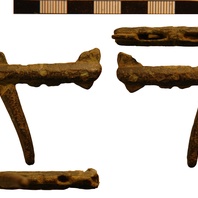
Viking Objects
Folding Arm Pivot Fragment (NLM-6A2893)
Scales were a common commerical tool and would have been an important part of any exchange whether using a monetary system or a bullion system, such as the one that existed in Viking-occupied areas of England.
Read More
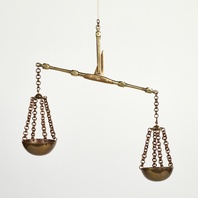
Viking Objects
Reproduction Scales
Scale pan set in copper alloy based on fragments of an arm from Cromwell, Nottinghamshire (DENO 0619F7), a pivot from Northope, Lincolnshire (NLM 6A2893), and a suspension arm and pans based on originals from York and St Peter’s Street, Northampton. Scales were a common commercial tool and would have been an important part of any exchange whether using a monetary system or a bullion system such as the one that existed in Viking-occupied areas of England.
Read More
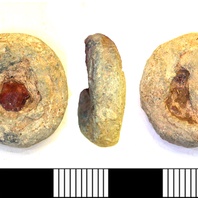
Viking Objects
Circular Weight (LEIC-5C4051)
This circular weight has a centrally placed orange stone chip inlaid into it. The distinction of weights by embedded objects or other embellishments in various media is a widely recognised feature of some early medieval weights. Weights are an important form of evidence for Viking Age commerce and the use of standards across the different economic systems within which Vikings were integrated. Many of the weights discovered, particularly ones in Ireland and those of Arabic type, suggest that a standardized system of weights existed in some areas. These standard weights, alongside standard values of silver, are what allowed the bullion economy of Viking occupied areas to function. A bullion economy was a barter economy that relied on the exchange of set amounts of precious metal in various forms, such as arm-rings or coins, for tradable goods, such as food or textiles. Each merchant would have brought their own set of weights and scales to a transaction to make sure that the trade was conducted fairly.
Read More
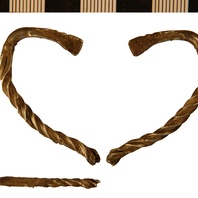
Viking Objects
Silver Arm-Ring (NLM-1B89B2)
This arm-ring fragment is made from strands of wire wound together into a single twisted or cabled strand with a cast zoomorphic terminal. This object was considered together with a group of fragments of ingots and hack-silver of probably contemporary date which were found nearby (NLM-1B0476). However, the mass of this object did not correspond closely to any of the systems of measurement thought to have been used for bullion transactions at that time. The Vikings arriving in England had a bullion economy where they paid for goods with silver that was weighed to an amount agreed between the buyer and the seller. Hacksilver and silver ingots are the most common evidence for their bullion economy. It took some time for the Scandinavian settlers to adopt a monetary economy like that of the Anglo-Saxons, and both systems were used simultaneously for a while before they fully adopted the new system. They were familiar with monetary economies but they treated coins as just another form of silver before adoption of a monetary economy
Read More
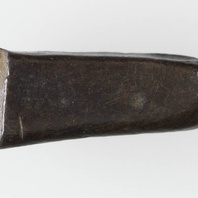
Viking Objects
Silver Ingot (CM.1789-2008)
This silver ingot was made by melting down worked silver cast into a rod and cut into sections. The Vikings arriving in England had a bullion economy where they paid for goods with silver that was weighed to an amount agreed between the buyer and the seller. Hacksilver and silver ingots are the most common evidence for their bullion economy. It took some time for the Scandinavian settlers to adopt a monetary economy like that of the Anglo-Saxons, and both systems were used simultaneously for a while before they fully adopted the new system. They were familiar with monetary economies but they treated coins as just another form of silver before adoption of a monetary economy.
Read More
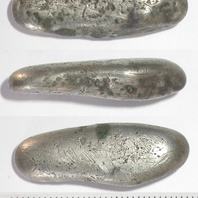
Viking Objects
Breedon Silver Ingot (X.A236.2009.0.0)
A Viking silver ingot which could have been used as bullion in payments or trade transactions, as well as a source of metal for jewellery making. The Vikings arriving in England had a bullion economy where they paid for goods with silver that was weighed to an amount agreed between the buyer and the seller. Hacksilver and silver ingots are the most common evidence for their bullion economy. It took some time for the Scandinavian settlers to adopt a monetary economy like that of the Anglo-Saxons, and both systems were used simultaneously for a while before they fully adopted the new system. They were familiar with monetary economies but they treated coins as just another form of silver before adoption of a monetary economy.
Read More
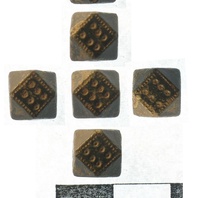
Viking Objects
Polyhedral Weight (SWYOR-3C5372)
This copper-alloy weight is of a type common within the Scandinavian diaspora. This example has fourteen sides and six dots on each of the rectangular sides. These weights were adopted by the Vikings from Middle Eastern examples and appear to have become a de facto weight standard for traders. Weights are an important form of evidence for Viking Age commerce and the use of standards across the different economic systems within which Vikings were integrated. Many of the weights discovered, particularly ones in Ireland and those of Arabic type, suggest that a standardized system of weights existed in some areas. These standard weights, alongside standard values of silver, are what allowed the bullion economy of Viking occupied areas to function. A bullion economy was a barter economy that relied on the exchange of set amounts of precious metal in various forms, such as arm-rings or coins, for tradable goods, such as food or textiles. Each merchant would have brought their own set of weights and scales to a transaction to make sure that the trade was conducted fairly.
Read More
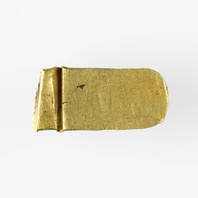
Viking Objects
Hack-gold (CM.1800-2008)
This rounded ingot terminal was cut from a larger rectangular ingot. Though rarer than hacksilver, this gold ingot formed part of the bullion currency used by Vikings in England and may be associated with their winter camp in Torksey.
Read More
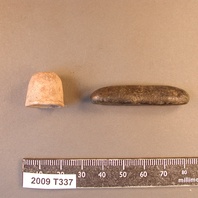
Viking Objects
Breedon Silver Ingot (X.A208.2010.0.0)
A cast silver ingot of typical Viking type. The photograph shows it alongside a lead gaming piece of a type that is increasingly being found within the Danelaw. This ingot could have been used as bullion in payments or trade transactions, as well as a source of metal for jewellery making. This particular ingot has slight irregularities from being made in an open mould and has two testing nicks on one edge. The Vikings arriving in England had a bullion economy where they paid for goods with silver that was weighed to an amount agreed between the buyer and the seller. Hacksilver and silver ingots are the most common evidence for their bullion economy. It took some time for the Scandinavian settlers to adopt a monetary economy like that of the Anglo-Saxons, and both systems were used simultaneously for a while before they fully adopted the new system. They were familiar with monetary economies but they treated coins as just another form of silver before adoption of a monetary economy.
